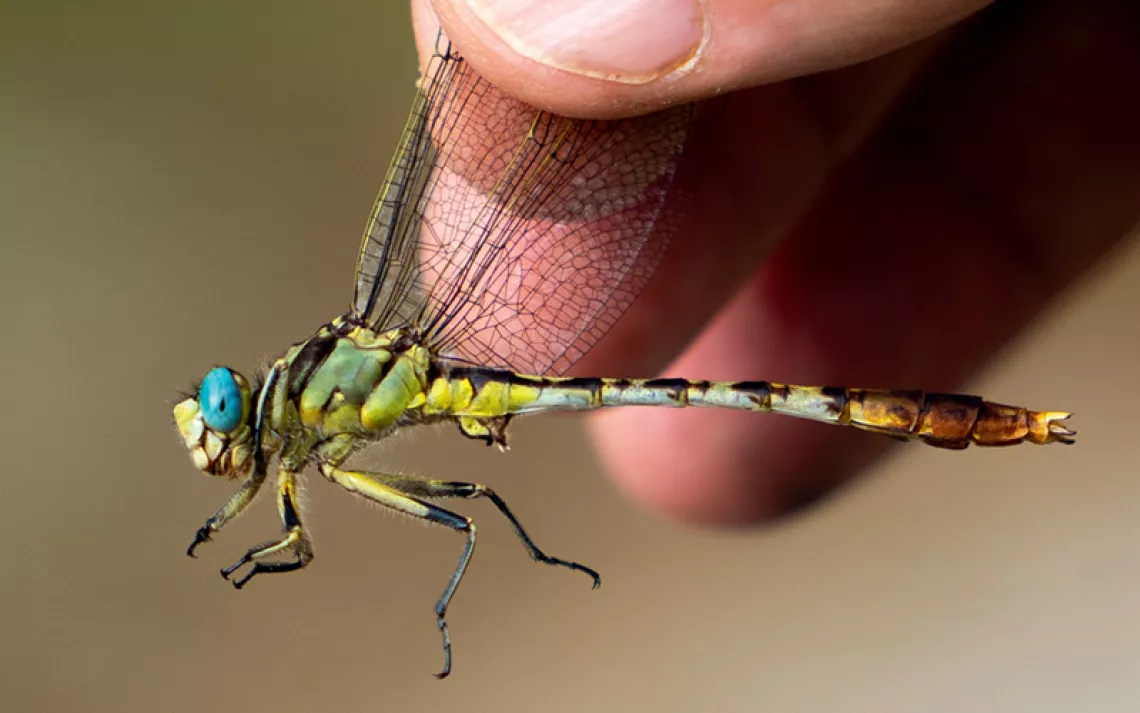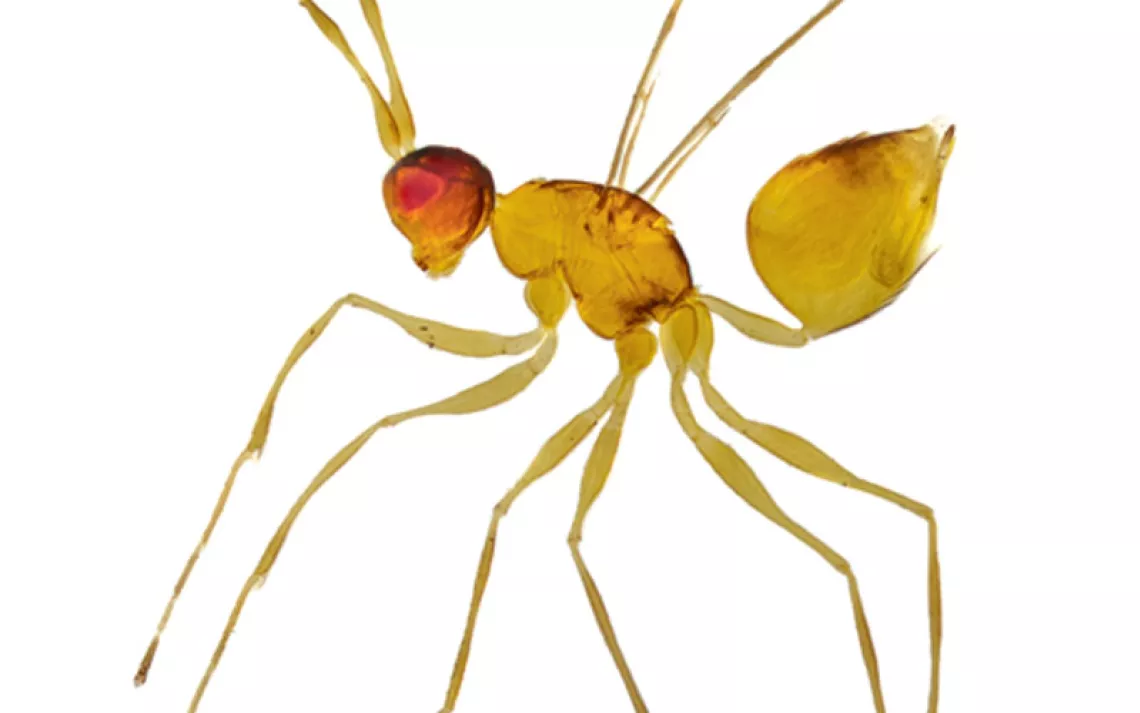The Brood X Cicadas’ 17-Year Itch
Get ready for love and romance, en masse

Photo courtsey of P. M. Shrewsbury
When I first moved to the Baltimore, Maryland, area in March 2004, everyone was talking about it: the year the 17-year cicadas would soon show up en masse. Having grown up in the Midwest, I thought cicadas just came out every year. You can hear their endless buzzing during the dog days of summer—it almost makes the days hotter. But why would this year be any different? Why was everyone freaking out?
And then I saw them. My colleagues had said it would look like moving tree bark, and they were right. Millions upon millions of Brood X periodical cicadas emerged from the ground, crawled up the trees as small skeletal-looking nymphs, shed that skin like so much armor, and then made their way into the treetops to sing at a deafening level and fly haphazardly looking for a mate. I was truly in awe.
Now here we are again in the mid-Atlantic 17 years later, anxiously awaiting this next arrival of Brood X. Some people are scared; others are very, very excited.
Like Dr. Michael J. Raupp, emeritus professor of entomology at the University of Maryland—or, as some call him, The Bug Guy. He is thrilled about Brood X and loves to share that passion with everyone he can.
“Oh, the best part for me as a scientist and ecologist is just to witness this very unusual and unique event where you literally have billions of cicadas coming out of the ground and striving for light,” he told me with excitement. In fact, for most of our conversation, he was genuinely excited. “They’ve had this dreary dismal existence under the earth for 17 years! Once they’re out, they’re up in the treetops and it’s romance. They’re singing their hearts out to find that special someone. It’s about love and romance. It’s like an episode of Outlander,” he laughed.
But there’s no need to worry—cicadas don’t bite or sting.

Photo courtesy of M. J. Raupp
Brood X is one of three species of 17-year cicadas. Residents in much of Maryland and parts of Pennsylvania and Delaware will see them this year. They are one to two inches long and feed on the xylem sap in trees. There are several hypotheses on why they—and the 13-year brood cicadas—spend so much time underground. One is that it helps them avoid predators if they show up in massive numbers—a term called “predator satiation.”
There are also the annual cicadas, like the ones I was thinking of when I first moved to Baltimore. The annual cicadas do not emerge in anywhere near the numbers as the 13- and 17-year cicadas. Residents across the mid-Atlantic and Midwest see cicadas from various broods in various years (USDA map here). And depending on which cicadas appear in your area, you may see, hear, or see and hear them.
“The cicadas that come out every year are awfully hard to see and catch. They depend on stealth and speed to avoid predators. They’re like F-14s when they fly,” explained Raupp. Then he laughed again. “But Brood X cicadas, those fly like the Hindenburg. They’re clumsy and they bump into everything. They will bump into people, but they won’t hurt you or carry you away.”

Photo courtesy of P. M. Shrewsbury
It’s true, one of the joys I had during the last Brood X invasion was seeing people wildly flail their arms while outside in response to a big cicada clumsily flying into their personal space. It happened to me on more than one occasion too. There’s nothing quite like the surprise of a large buzzing insect flying directly into your face.
The only threat cicadas pose is to tree saplings and recently transplanted trees. After mating, the female cicadas will create a small slit in a tree limb to lay their eggs. Annually, there are not enough cicadas doing that to affect a tree. But in a periodical cicada year, the millions of insects laying eggs can cause “flagging” in young trees, where parts of branches turn brown and die.
Raupp advises putting up netting with a one-centimeter mesh on these at-risk trees, but make sure you check the tree for any bird nests or tree-dwelling reptiles first.
“Netting means you’re not risking adding pesticides to the environment that could harm pollinators and other beneficial insects,” Raupp said. He also said that studies have shown that pesticides don’t help, because while a pesticide may kill the cicadas on the tree that day, a day or two later there will be more cicadas on whatever was sprayed.
Raupp is also worried for people who have a genuine fear of the cicadas. “I’m trying to help people through this,” he said. “For people who are truly scared, I recommend counseling or scheduling a vacation in a nearby area where Brood X won’t be emerging. Cicadas are big, that’s true, but they won’t harm people or pets.”
They are also safe to eat for dogs and cats (in moderation, he said) and even for people to eat as well. Raupp said a former graduate student of his even wrote a cookbook called Cicadelicious, should anyone want to try some recipes. He himself will eat them right off the tree trunk after they’ve emerged.
“If you really want the true flavor, eat them right when they come out of the soft shell,” said Raupp. “It’s like eating an oyster or clam. It’s a buttery texture, and a nutty flavor from them feeding on the plant roots underground.” He added that they’re also good cooked into an omelet.
Brood X will truly be a buffet for the animal world, as just about every critter Raupp can think of eats the bountiful bugs when they’re out. “Foxes, raccoons, skunks, birds, turtles, skinks—everybody wants to eat them,” said Raupp.
The Brood X emergence and all-you-can-eat buffet will start in early-to-mid-May and will wrap up in late June. If you don’t know whether they will appear in your neighborhood because you weren’t there in 2004, ask your neighbors. If you’re planning a spring outdoor event, ask the venue if they had them in 2004. If yes, either prepare yourself or reschedule for later in the summer.
Raupp hopes that even if he can’t teach everyone to love cicadas as much as he does, he can at least get people to marvel at their magic.
“They’re called magicicadas, literally,” Raupp said. “For most who love nature and natural history and living things, this is a spectacular opportunity to immerse yourself in a truly amazing event that happens nowhere else in the universe. You’ll have all this drama happening in your backyard. It’s like having a National Geographic or BBC nature documentary right there.”
 The Magazine of The Sierra Club
The Magazine of The Sierra Club



